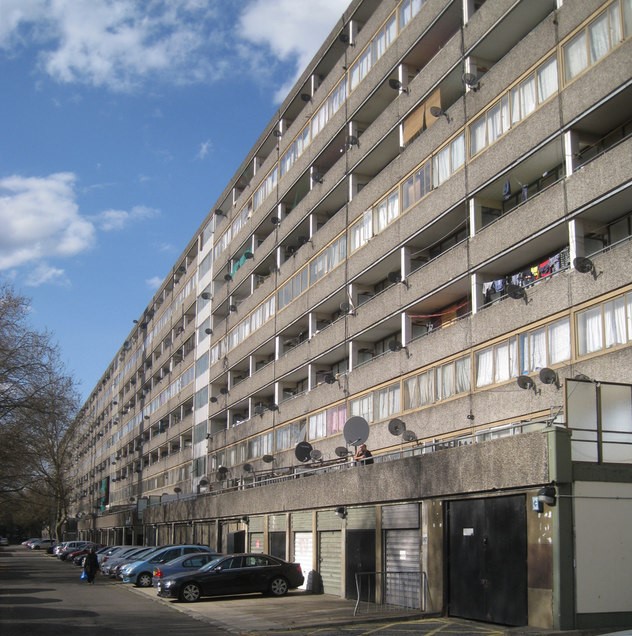Medium-rise building

|
| 10-storey Wendover flats facing Thurlow Street, Aylesbury Estate, Walworth, London cc-by-sa/2.0 - © Robin Stott - geograph.org.uk/p/5326176 |
Contents |
[edit] Introduction
A medium-rise or mid-rise building is loosely defined as a structure that has between five and 10 storeys and is equipped with a lift. More specifically, the National Fire Chiefs Council classifies medium-rise buildings as ‘structures whose uppermost habitable floor is less than 30m and greater than 18m above ground level measured from the lowest side of the building’. This definition is based on the knowledge that standard firefighting turntables have not historically been able to access buildings that are more than 18m high.
The National Fire Chiefs Council sets out addition requirements for medium-rise buildings:
- Compliance with Class 0 external surface requirements for the building envelope.
- Firefighting shafts with firefighting lifts.
- Increased time periods for structural fire resistance based on fire suppression systems within the building.
[edit] The 18m issue
The Home Quality Mark uses the 18m height specification to define high-rise buildings. This height has also been adopted by guidance following the publication of the Independent review of the building regulations and fire safety (also known as the Hackett Review) in 2018.
In December 2018, a Ministerial Working Group in Scotland made a change to its definition of a high-rise building with relationship to fire safety standards. This included a reduction in height from 18m to 11m. It did not include specifications for medium-rise buildings.
In January 2020, following a fire in a block of student accommodation (which was just under 18m) in Bolton in 2019, the government launched a consultation including proposals to lower the 18m height threshold for 'high-rise' to 11m.
[edit] The future of medium-rise buildings
There is no precise consensus as to what constitutes a high-rise building. This has had a cascading effect on definitions of both medium- and low-rise buildings. Low-rise buildings are sometimes referred to as those not tall enough to be classified as high-rise, which subverts the medium-rise classification.
Some industry experts speculate that fire and safety regulations may increase the preponderance of medium-rise buildings - or shorter high-rise towers. Some of these buildings are referred to as groundscrapers, since they extend horizontally over a large distance while only being of a low to medium height.
[edit] July 2021 update
On 21 July 2021, the Independent Expert Group released its statement on building safety in medium- and lower-rise blocks of flats. The group had been asked by the Government to consider issues of proportionality in relation to building safety in medium- and lower-rise blocks of flats, the impact on the housing market and what more the Government could do to ensure approaches that are proportionate to the level of risk.
The statement made several observations, including:
- Building owners should ensure that residential buildings of any height are safe, as it is their longstanding legal responsibility to do so. However, there has been a disproportionate reactions to the level of risk in medium- and lower-rise buildings such as some surveyors seeking excessive amount of additional information on risks and safety to offer mortgage valuations; some insurers raising buildings insurance premiums and withdrawing or placing punitive exclusions on professional indemnity insurance; and some fire risk assessors taking an unnecessarily risk averse approach in identifying risks and recommending remedial works –which may not be necessary, and impose unjustified costs.
- The impact of these market responses and building safety issues in medium-rise blocks of flats has been significant and is causing serious distress and anxiety to many residents - not only in relation to cost but also heightening their fears about the safety of the buildings themselves. We believe that Government intervention is necessary to correct that over-reaction in the market as soon as possible and to reassure residents by providing some context about the true extent of risk that they are living with.
- Initial results of surveys of medium rise blocks of flats indicate that the vast majority are free from serious safety risks associated with unsafe cladding requiring remediation, and from any associated costs. Only a small proportion of medium rise blocks of flats might have cladding systems that could require further assessment.
- The evidence is clear that the risk of fire related fatalities is very low in buildings of any height. Government’s decision to focus its attention on greater risks from fire spread in high rise buildings of 18m and over is a proportional response to the level of risk. Furthermore, the evidence on medium rise blocks of flats over four storeys shows that incidences where fires spread are rare. Given this low level of risk, there is no need for surveyors or lenders to request EWS1 forms for buildings below 18m. Fire risk assessments should continue in the usual course of business for all blocks of flats to meet the requirements of the Fire Safety Order, but conducting ad hoc building by building additional assessments should not be necessary.
The Government announced it will support and act upon the recommendations.
- EWS1 forms should not be a requirement on buildings below 18 metres.
- In the small number of cases where there are known to be concerns these should be addressed primarily through risk management and mitigation.
- There should be a clear route for residents/leaseholders to challenge costly remediation work and seek assurance that proposals are proportionate and cost effective.
- Government should work with the shadow Building Safety Regulator to consider how to implement an audit process to check that fire risk assessments are following guidelines, not perpetuating the risk aversion we are witnessing, in some instances, at the present time.
- Fire risk assessors, and lenders should not presume that there is significant risk to life unless there is evidence to support this. This would ensure that they respond only to the evidence and adopt a far more proportionate and balanced approach.
Ref https://www.gov.uk/government/speeches/proportionality-in-building-safety
[edit] Related articles on Designing Buildings Wiki
Featured articles and news
Retired firefighter cycles world to raise Grenfell funds
Leaving on 14 June 2025 Stephen will raise money for youth and schools through the Grenfell Foundation.
Key points for construction at a glance with industry reactions.
Functionality, visibility and sustainability
The simpler approach to specification.
Architects, architecture, buildings, and inspiration in film
The close ties between makers and the movies, with our long list of suggested viewing.
SELECT three-point plan for action issued to MSPs
Call for Scottish regulation, green skills and recognition of electrotechnical industry as part of a manifesto for Scottish Parliamentary elections.
UCEM becomes the University of the Built Environment
Major milestone in its 106-year history, follows recent merger with London School of Architecture (LSE).
Professional practical experience for Architects in training
The long process to transform the nature of education and professional practical experience in the Architecture profession following recent reports.
A people-first approach to retrofit
Moving away from the destructive paradigm of fabric-first.
International Electrician Day, 10 June 2025
Celebrating the role of electrical engineers from André-Marie Amperè, today and for the future.
New guide for clients launched at Houses of Parliament
'There has never been a more important time for clients to step up and ...ask the right questions'
The impact of recycled slate tiles
Innovation across the decades.
EPC changes for existing buildings
Changes and their context as the new RdSAP methodology comes into use from 15 June.
Skills England publishes Sector skills needs assessments
Priority areas relating to the built environment highlighted and described in brief.
BSRIA HVAC Market Watch - May 2025 Edition
Heat Pump Market Outlook: Policy, Performance & Refrigerant Trends for 2025–2028.
Committing to EDI in construction with CIOB
Built Environment professional bodies deepen commitment to EDI with two new signatories: CIAT and CICES.
Government Grenfell progress report at a glance
Line by line recomendation overview, with links to more details.
An engaging and lively review of his professional life.
Sustainable heating for listed buildings
A problem that needs to be approached intelligently.
50th Golden anniversary ECA Edmundson apprentice award
Deadline for entries has been extended to Friday 27 June, so don't miss out!
CIAT at the London Festival of Architecture
Designing for Everyone: Breaking Barriers in Inclusive Architecture.
Mixed reactions to apprenticeship and skills reform 2025
A 'welcome shift' for some and a 'backwards step' for others.




























